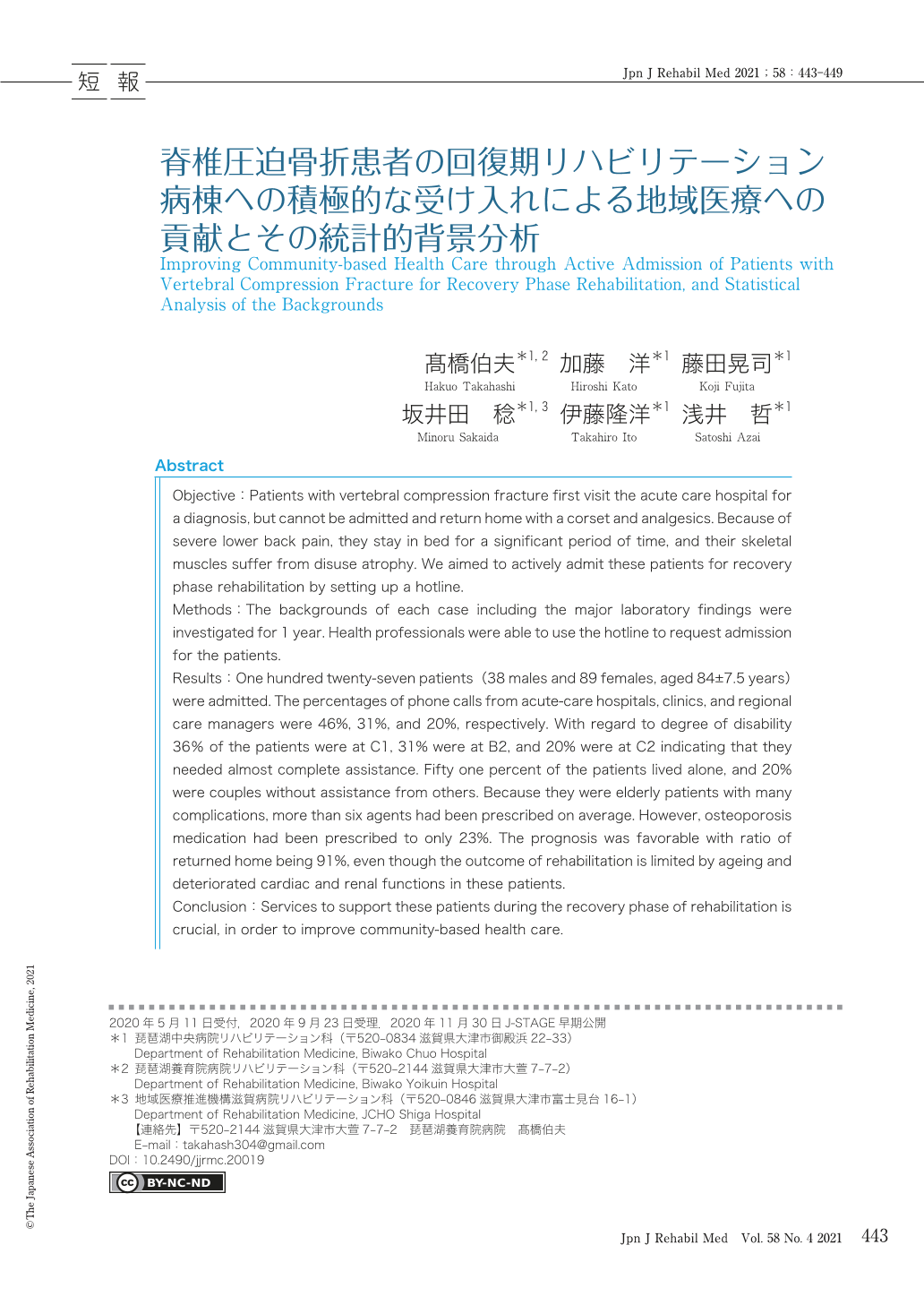Japanese
English
- 販売していません
- Abstract 文献概要
- 1ページ目 Look Inside
- 参考文献 Reference
要旨
目的:近年,脊椎圧迫骨折が急増するも,患者は在宅療養で廃用が進む.そこで,積極的なリハビリテーション治療に取り組んだ成果と背景分析結果を報告する.
方法:地域連携室に直通のホットラインを設けて受け付け,ストレッチャーで収容可能な専用車両を準備して患者を収容した.
結果:約1年間に127名を収容した.急性期病院,診療所,ケアマネジャーからそれぞれ46%,31%,20%依頼され,年齢は84±7.5歳で,男性38名と女性89名である.入院時の日常生活自立度はC1,B2,C2がそれぞれ36%,31%,20%と,日常生活で困窮する例が大半であった.併発症を多く有するので6剤を超える多剤服用者が61%いる一方で,骨粗鬆症の治療は23%でしか実施されていなかった.
家庭環境では,独居が51%とほぼ半数を占め,夫婦2人が20%,親子2人が15%で,大半の家庭内で満足できる介護の状況でなかった.
また,リハビリテーション治療の遂行に障害となる要因を統計的に分析したところ,加齢,心・腎機能低下が課題として浮上したものの予後は良好で,91%は自宅または介護施設へ退院した.
結論:独居の高齢女性に多く,大半がほぼ全介助の状態にある本症患者を積極的に回復期リハビリテーション病棟に収容することは,地域医療においてきわめて重要である.
Objective:Patients with vertebral compression fracture first visit the acute care hospital for a diagnosis, but cannot be admitted and return home with a corset and analgesics. Because of severe lower back pain, they stay in bed for a significant period of time, and their skeletal muscles suffer from disuse atrophy. We aimed to actively admit these patients for recovery phase rehabilitation by setting up a hotline.
Methods:The backgrounds of each case including the major laboratory findings were investigated for 1 year. Health professionals were able to use the hotline to request admission for the patients.
Results:One hundred twenty-seven patients (38 males and 89 females, aged 84±7.5 years) were admitted. The percentages of phone calls from acute-care hospitals, clinics, and regional care managers were 46%, 31%, and 20%, respectively. With regard to degree of disability 36% of the patients were at C1, 31% were at B2, and 20% were at C2 indicating that they needed almost complete assistance. Fifty one percent of the patients lived alone, and 20% were couples without assistance from others. Because they were elderly patients with many complications, more than six agents had been prescribed on average. However, osteoporosis medication had been prescribed to only 23%. The prognosis was favorable with ratio of returned home being 91%, even though the outcome of rehabilitation is limited by ageing and deteriorated cardiac and renal functions in these patients.
Conclusion:Services to support these patients during the recovery phase of rehabilitation is crucial, in order to improve community-based health care.

Copyright © 2021, The Japanese Association of Rehabilitation Medicine. All rights reserved.


